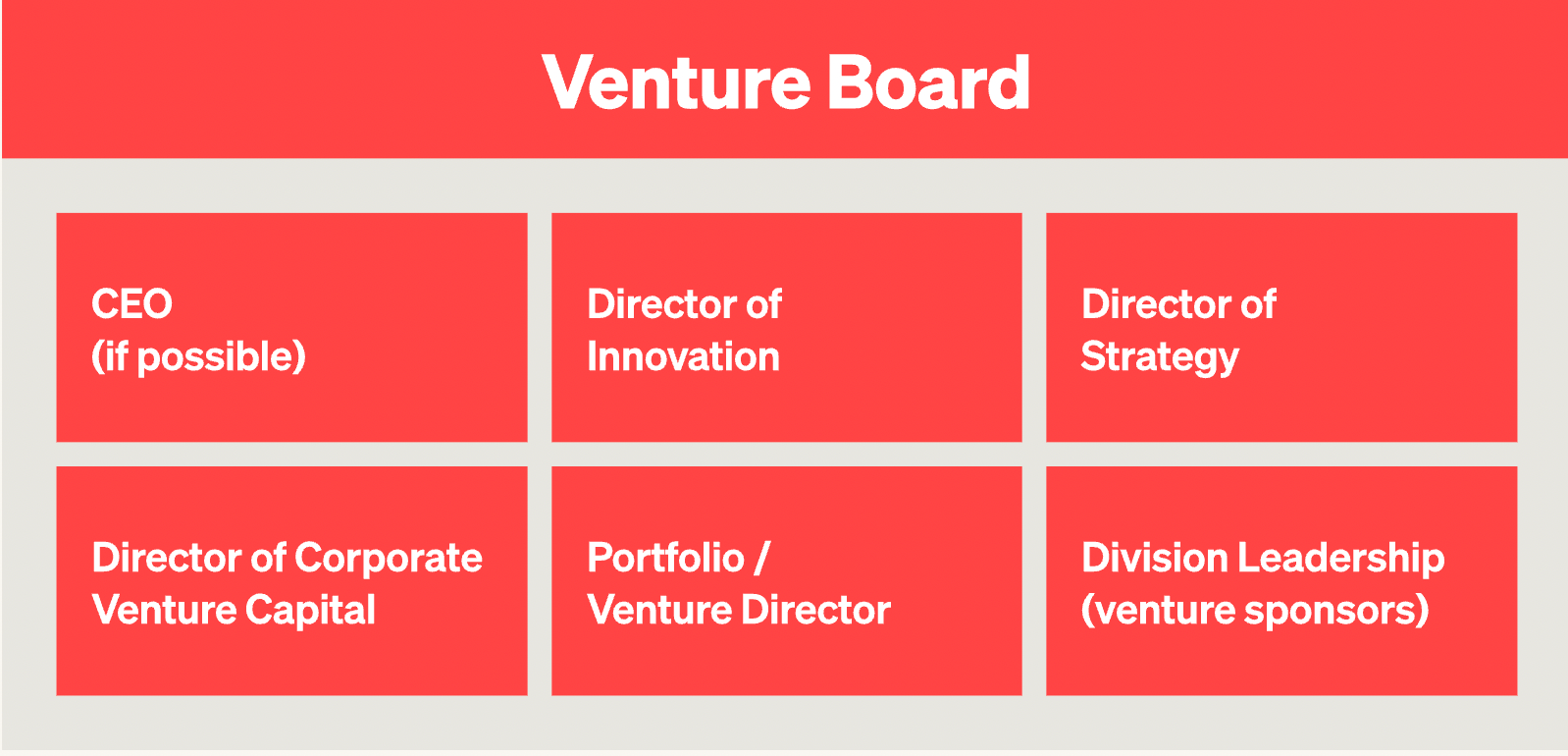Key takeaways
For years now, companies all over the world have been leveraging corporate venturing as a strategy to boost innovation - and the results have been stellar. Alphabet’s Wing, Rabobank’s SurePay, and General Motor’s Cruise are just a few examples that illustrate how corporate venturing can unlock unprecedented growth opportunities, enabling corporations to:
- Expand beyond their core
- Access new markets
- Create new revenue streams
- Gain a competitive edge
A crucial part of ensuring the success of your ventures is to identify and establish the right governance, funding, and legal setup—a triad that serves as the backbone of their operations:
- Governance structures help you navigate the balance between autonomy and control.
- Funding will sustain your ventures from idea to scale and beyond.
- Legal frameworks ensure compliance, safeguard your venture and enable growth.
To help you navigate the process, we’ve crafted this comprehensive guide with tips and insights based on our years of experience building, partnering and investing in corporate ventures.
Choosing the right governance structure for your corporate venture
The governance model of your corporate venture is critical in determining the direction of your business. It is the framework that outlines the decision-making process and how the business is run. Elements of a strong governance framework include:
- Clear roles and responsibilities for the venture board and management team
- Transparent and timely communication
- Policies and procedures that guide decision-making
- Regular review and updating of your governance framework
While every venture is unique, in most cases, you’ll need a setup that includes:
- A venture board: corporate sponsors that provide strategic advice
- A venture team: developers, creatives and experts that execute ideas
The venture board
In our experience, setting up a venture board has been by far the strongest contributor to the long-term success of a venture, from the early stages and far beyond. It's an absolute requirement for building winning ventures.
In most cases, a venture board includes corporate stakeholders or sponsors who regularly meet with the venture team to provide strategic advice and guidance. For example, if your venture is still in its early stages (i.e. MVP phase or before the first 100 customers), it’s recommended that you meet with the venture board on a monthly basis to ensure goals and strategies are aligned. However, in later stages (e.g. post-MVP), when the venture concept is more solidified, venture board meetings can take place on a quarterly basis.
Venture board profiles often include one or more of the following:

The input provided by a venture board is extremely valuable to venture teams because it keeps them plugged into the broader corporate agenda. This, in turn, will increase their chances of:
- Getting the funding and resources they need to move forward
- Keeping their strategy and KPIs on track
- Making decisions with the full support of the mothership
- Maintaining a smooth pathway for spin-in or spinout scenarios
The venture team
Venture teams take charge of the everyday execution of various tasks under the guidance of the venture board. In most cases, you’ll need two separate venture teams, one for the venture creation phase and one for the venture growth phase.

For example, during the first few months of building a new venture, your focus will be to bring your new concept to life (i.e. venture creation). This will most likely involve the following:
- Problem discovery and validation
- Solution discovery and validation
- Prototyping
- MVP
- Pilot run
You’ll need a team that’s creative, loves to ideate and knows how to validate new value propositions effectively. Ideal profiles include:

In many cases, the profiles that make up the venture creation team are hired from the corporate itself, with the flexibility and security to go back to their original position (or to the next venture) once the creation phase is over.
On the other hand, the venture growth stage requires profiles with launch and scale experience that can take ownership of the venture’s strategy, finances and growth milestones moving forward. Profiles include:

In contrast to venture creation profiles which usually have more security, venture growth profiles are generally more entrepreneurial and open to risk. They’re hired externally and are highly invested in the success of the venture. Higher risks and higher rewards.
Choosing the right funding setup for your corporate venture
Funding is the lifeblood of any business, and choosing the right funding setup is critical to the success of your corporate venture. Let’s take a look at some of the potential options:
Internal funding
Internal funding involves allocating a portion of the corporate parent's capital to finance the corporate venture.
This approach offers several benefits, including:
- Full control over the venture's direction and decision-making.
- No need to search for external investors, which can save time and effort.
- The potential to leverage existing resources and expertise within the company.
Disadvantages include:
- Potential conflicts of interest between the venture and the parent company's core business.
- The risk of the venture becoming too insular and not benefiting from external perspectives and expertise.
- Lack of agility and flexibility.
External funding
External funding involves raising capital from outside investors, such as venture capitalists, banks, or strategic partners.
This funding approach can provide several advantages:
- Access to larger pools of capital, which can accelerate growth and expansion.
- An opportunity to leverage external expertise and industry connections.
- A stronger validation of the venture's potential, as external investors contribute their own resources.
Disadvantages include:
- The need to relinquish some control over the venture's direction and decision-making.
- The time and effort required to find and secure external investment.
- The risk of diluting the parent company's ownership and influence.
Hybrid funding
Hybrid funding combines elements of both internal and external funding, offering a more balanced approach.
Advantages include:
- Diversifying the venture's financial resources.
- Maintaining a degree of control while also benefiting from external input.
- Building a more dynamic and agile venture that is better equipped to respond to market conditions.
Disadvantages include:
- The complexity of managing multiple stakeholders with potentially conflicting interests.
- Challenges establishing good communication between the parent company, the venture, and external investors.
When choosing a funding setup for your corporate venture, consider the following factors:
- Strategic alignment: Ensure that your funding setup aligns with your company's overall strategy, objectives, and long-term vision.
- Risk tolerance: Choose a funding setup that aligns with your company's risk appetite.
- Resource availability: Evaluate your company's available resources (e.g. financial capital, human capital, and existing infrastructure) to support the chosen funding setup.
- Innovation potential: Consider the potential for innovation and growth offered by each setup, and select one that provides the greatest opportunities for your venture to thrive.
- Cultural fit: Assess the compatibility between your company's culture and the funding setup's requirements, ensuring a smooth integration.
Choosing the Right Legal Setup for Your Corporate Venture
Finding the right legal entity setup for your corporate venture will have a crucial impact on its success and how fast it reaches profitability. With so many options to choose from (e.g. spin-off, spin-in, business unit, etc.), it can be a daunting process with no straightforward answer.
For the purposes of this article, we’ll focus on business units, spin-offs and joint-ventures since they’re the most common options for companies that want to expand past their core activities to accelerate growth. We’ll start by taking a closer look at each of these legal entities:
What is a business unit?
A business unit is a fully functional unit with its own vision and direction. Typically, strategic business units operate as separate entities while remaining an essential part of the existing legal structure of the parent company.
What is a spin-off?
A spin-off refers to the process of creating a new company that operates separately from an existing one (e.g. through the creation of a subsidiary or joint-venture). Spin-offs have their own assets and distinct business operations that are no longer under the parent company’s control.
What is a joint-venture?
A joint-venture is a strategic arrangement between two or more companies where they pool resources and expertise to achieve a common goal. Each company brings a specific set of resources to the table in exchange for a share of the revenues and control of the venture.
Make sure to carefully examine the characteristics of each entity so that you can make an informed decision about which one fits your company best. To help you make an informed decision, we’ve listed some of them below:
.jpeg)
When determining the ideal legal entity for your corporate venture, consider its proximity to your core business. The more removed it is, the less likely it will be to rely on core assets, making a spin-off arrangement the better option. Use the innovation matrix below to help guide your decision.
.png)
Final thoughts
Choosing the right governance, funding, and legal setup for your corporate venture is a critical step in building a solid foundation for success. By carefully considering the options available and weighing their pros and cons, you can make informed decisions that will help your corporate venture thrive in today’s competitive business landscape.
Connect with us on LinkedIn for more valuable corporate venturing insights and content.
__________
Want to build a bulletproof foundation to take your venturing activities to the next level? Our services encompass everything from identifying high-potential areas to customised venture unit strategies tailored to your long and short-term growth goals.
Scaling corporate ventures: the foundations.
Discover and understand the critical actions needed on the venture journey to scale successfully.








